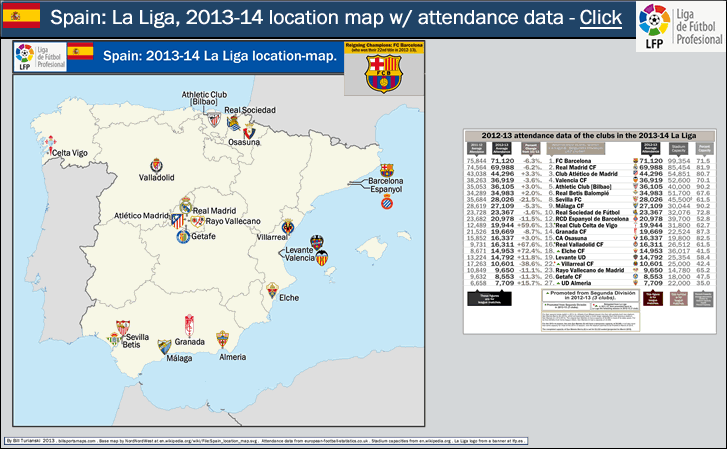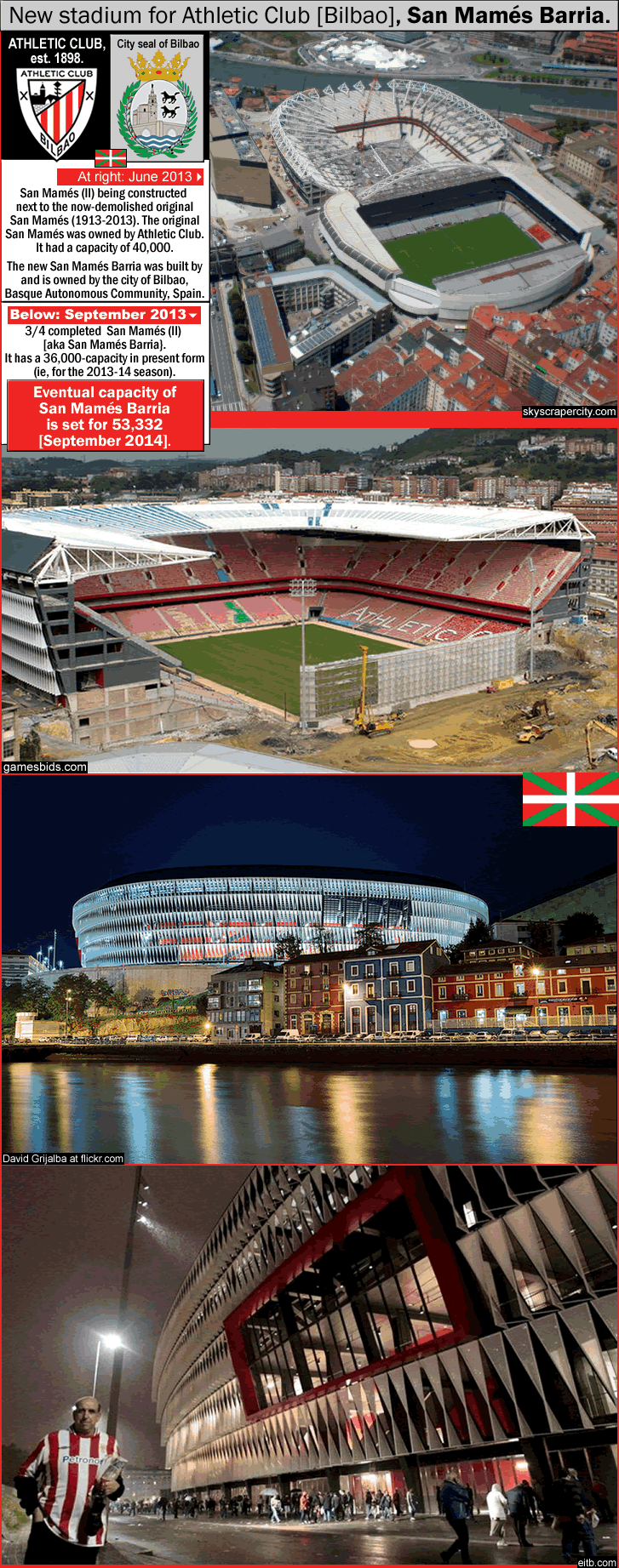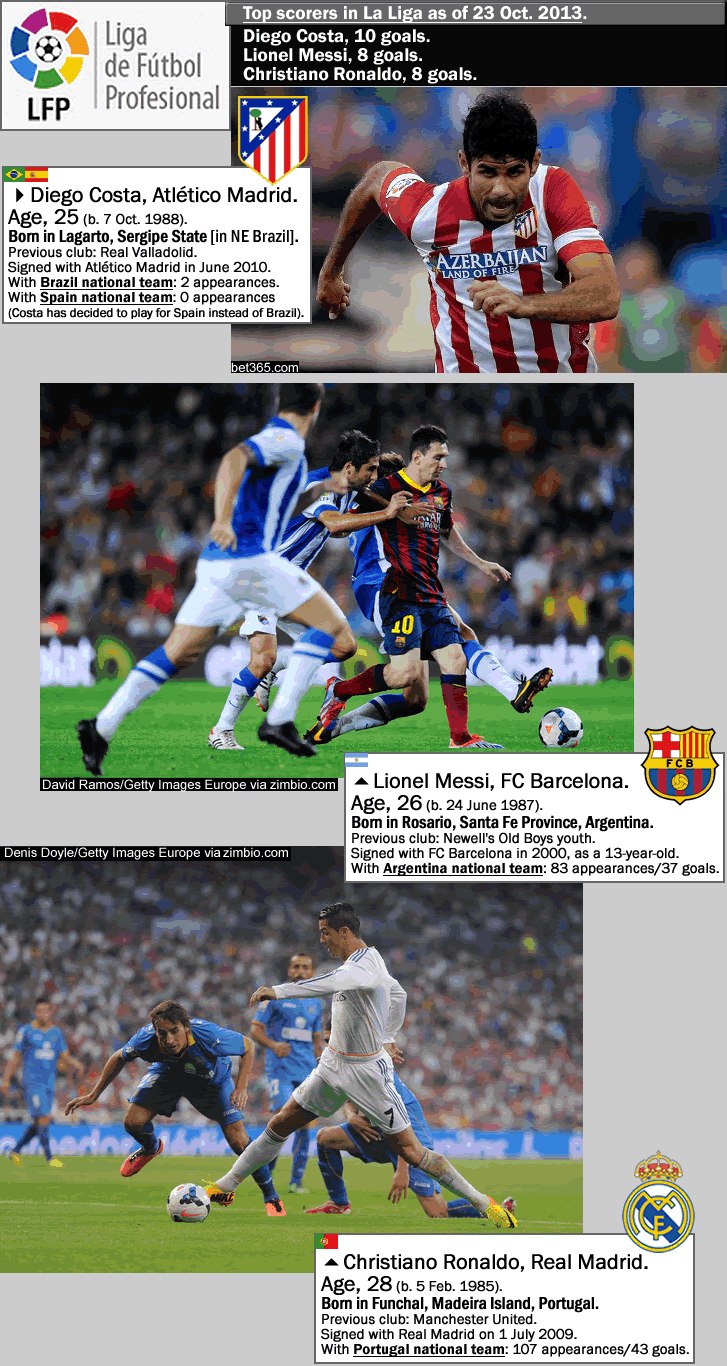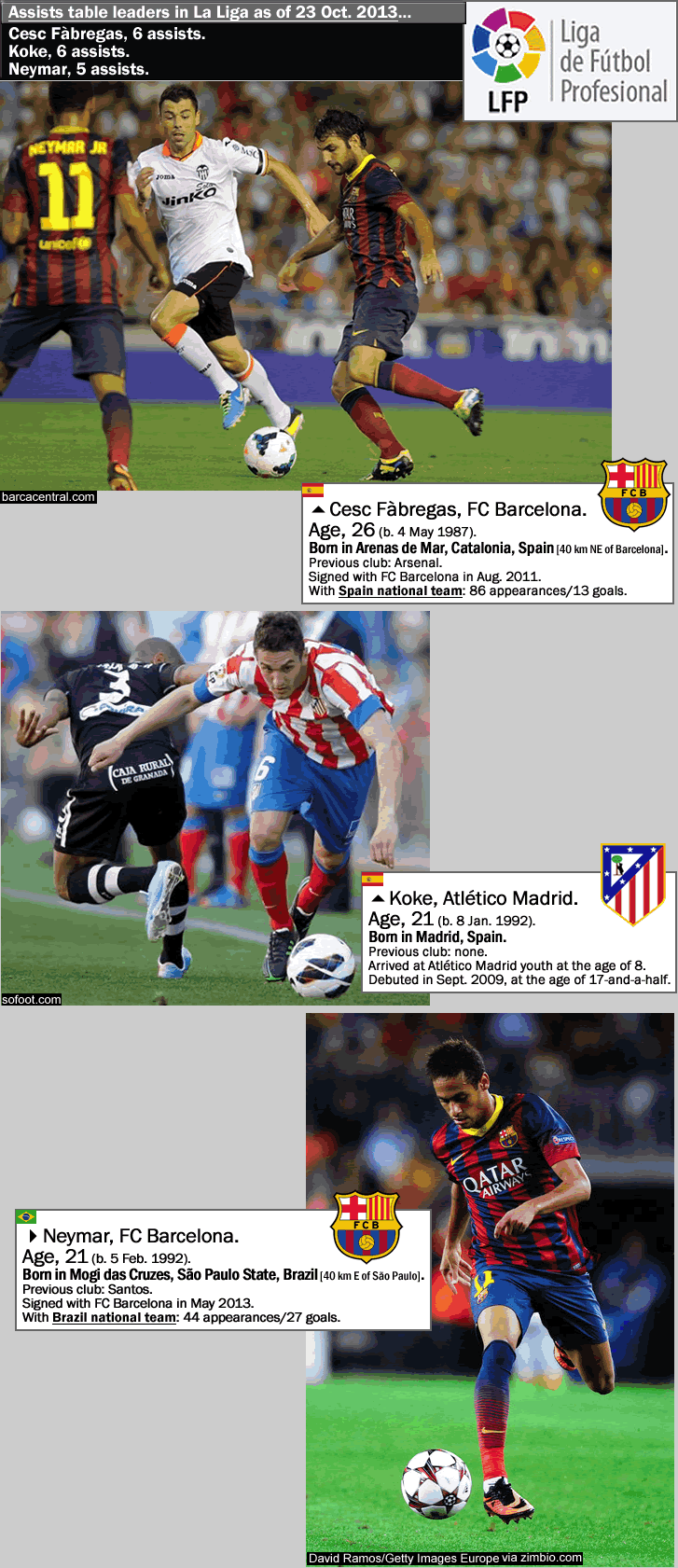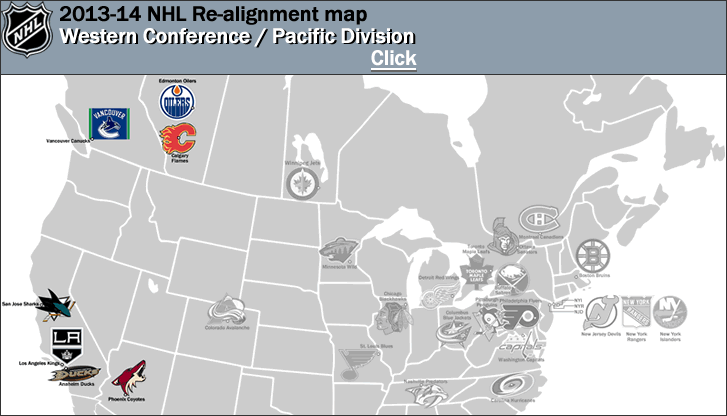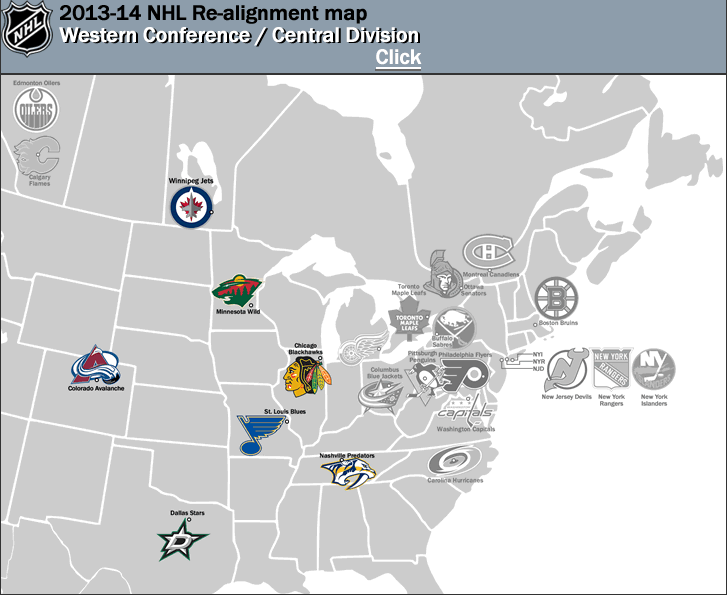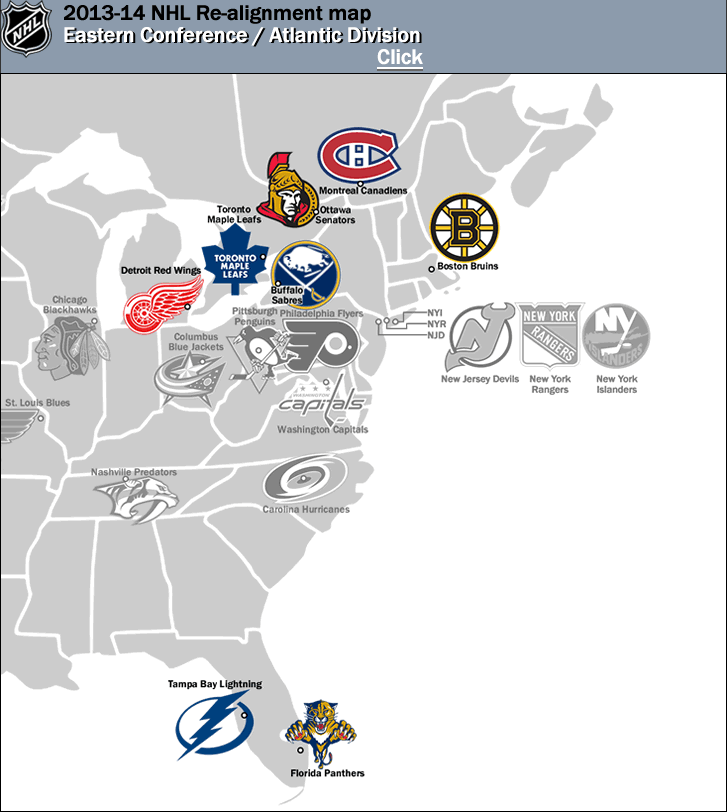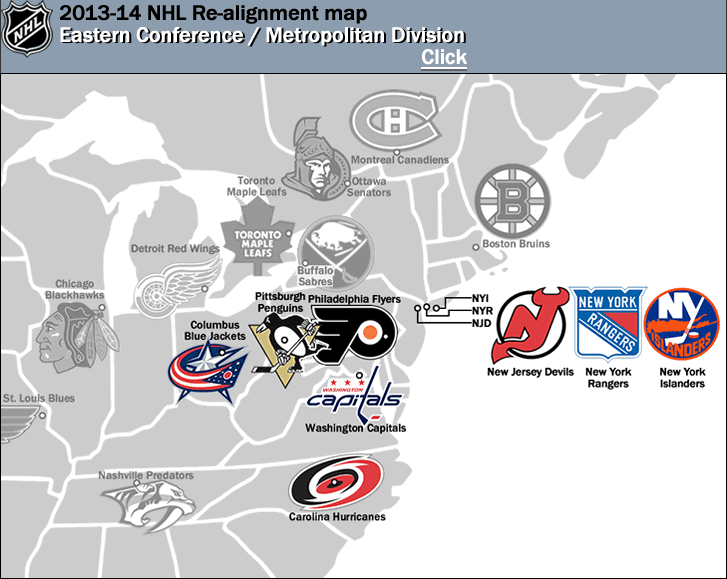Note: to see my latest map-&-post of the English 3rd division, click on the following, Eng-3rd Level/League One.
.
.
.
.
.
.
.
.
.
.
.
.
.
.

England, 3rd division: Football League One – 2013-14 Location-map, with attendance data & 2013-14 home kit badges
…
…
On the map page
Facsimiles of each clubs’ home jersey badges for the 2013-14 season are shown, in alphabetical order, across the the top of the map page. Below that, at the lower left, is a location-map of the clubs in the 2013-14 Football League One. At the right-hand side of the map page is attendance data for current League One clubs from the two previous seasons (2011-12 and 2012-13). Change (by percent), as well as percent capacity (ie, how much the club filled their stadium on average) from last season, are shown. League movement (if any) of the clubs is shown as well.
…
Below, top 3 clubs in the League One table, as of 14 October 2013…
Leyton Orient, 1st place as of 14 October 2013.
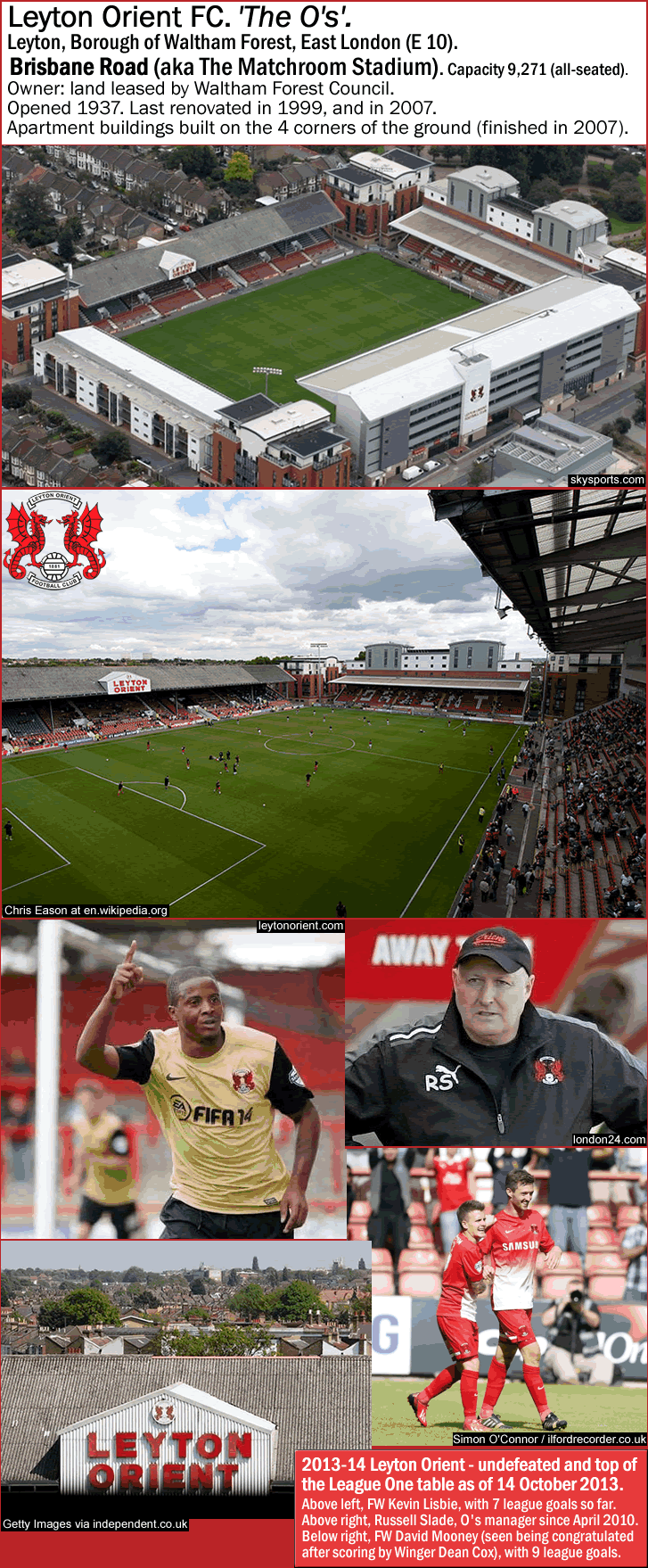
Photo credits above -
Aerial photo of Brisbane Road from skysports.com.
Interior photo of Brisbane Road by Chris Eason at en.wikipedia.org/wiki/File:Brisbane_Road.jpg & at flickr.com/photos/45189308@N00.
Photo of Kevin Lisbie from leytonorient.com.
Photo of Russell Slade from london24.com.
Photo of David Mooney by Simon O’Connor at ilfordrecorder.co.uk/sport/sport-football/orient/orient_lose_perfect_record.
Photo of the old gabled Orient sign at Brisbane Road with a view of Waltahm Forest borough in the background, photo fro Getty Images via independent.co.uk/sport/football/news-and-comment/giving-the-name-away-stadiums-named-after-sponsors-gallery.
Leyton Orient are a traditionally lower-leagues Football League club that is located in East London and who play at the 9,271-capacity Brisbane Road. Brisbane Road is also known as the Matchroom Stadium, and has, since 2007, multi-story apartment buildings in each of the 4 corners of the ground – see this photo from the following article by John Ashdown at Guardian.com/football, ‘At which grounds can you watch football for free?‘). [Note: the ground is named after Leyton Orient chairman Beary Hearn's sports promotion company, Matchroom Sport.].
The club now known as Leyton Orient was originally formed by members of the Glyn Cricket Club in 1881. The club began fielding a football team in 1888, under the name Orient Football Club. This name change came about on the suggestion of a player, Jack R Dearing, who worked for the Orient shipping line (later the P&O Line). This was a fitting moniker, as ‘orient’ means east and the club has always called East London its home. The club’s name was changed again to Clapton Orient in 1898 to represent the area of London in which they played at the time (their location back then was a few km. west of the O’s current location). As Clapton Orient FC, the club were, along with 5 other clubs, allowed to join the newly-expanded Second Division in 1905-06, when the Football League expanded by 4 teams (from 36 to 40) – with both the First Division and the Second Division expanding from 18 to 20 teams. {See this, ‘1905-06 Football League/Second Division‘ (en.wikipedia.org)}. Clapton Orient finished dead last in their first season in the League (there was no automatic relegation out of the League until 1986-87). Leyton Orient did end up being relegated 23 years later (in 1928-29), to the Third Division (South) [which had been instituted in 1920-21]. While still in the 3rd-division-South, the club (still known as Clapton Orient) moved a few kilometres east to their present location in Leyton, which was at that time a borough of Essex (see 2 sentences below), and into Brisbane Road, where the club have played ever since. A decade later, in 1947, to properly reflect their somewhat-recent location-change, their name was belatedly changed to Leyton Orient. That only lasted two decades, because there was yet another name change in 1966, to simply Orient FC – this after the borough of Leyton (which was at that point situated in Essex) was absorbed into the London Borough of Waltham Forest. 21 seasons later, in 1987, partly as the result of the wishes of many longtime Orient supporters, the club returned to their Leyton Orient name. The club has undergone several crises in its history, and another crisis might be looming on the horizon (see 4 paragraphs below).
Leyton Orient are the second-oldest League club in London, behind Fulham, and are the 24th-oldest club currently playing in the Football League. Leyton Orient have spent exactly one season in the first division. That was in 1962-63, at the early part of the Swinging London era, under the management of Johnny Carey, who got Leyton Orient into the top flight by finishing in second in the 1961-62 Second Division (Liverpool won the Second Division that season). Leyton Orient struggled in the top flight in 62/63, and were relegated as last-place-finishers with only 6 wins in 46 games. But they did defeat local rivals West Ham United at home that season. So there was at least that.
When Leyton Orient played that one season in the first division they wore blue and white colors – Leyton Orient wore blue jerseys and white pants from 1947-48 all the way to 1966-67 (19 seasons). In 1967-68, red jerseys were adopted once again (the club had started out in red jerseys back in the late 1800s/early 1900s, then played for around two decades with white-jerseys-featuring-a-large-red-V [from 1910 to 1931]). In 1970-71, the mythical beast the Wyvern first appeared on a Leyton Orient crest. {See this, Leyton Orient kit & crest history here (historicalkits.co.uk)}.
{note, attendance data for the following two sentences found here (european-football-statistics.co.uk)}.
When Leyton Orient had that solitary first-division season-in-the-sun in 62/63, they drew drew 16,206 per game, which is more than 3 times what the club draws these days. The club’s all-time biggest average crowd was in 1956-57, at 17,524 per game (56/57 was the first season that Leyton Orient were back in the second division after 20 seasons in the third tier [since 1928-29]). Compare that to last season [2012-13], when Leyton Orient drew just 4,006 per game. Last season, Orient started poorly under ex-Brighton and ex-Yeovil Town manager Russell Slade (who has been in charge at Brisbane Road since April 2010), but Leyton Orient’s second-half form was among the best in the third division, and they ended up just short of a play-off place in 7th (4 points behind Swindon). This season, Orient are continuing the fine form they displayed in the latter half of the last campaign. For their first 5 home matches in 13/14, attendance had picked up around 600 per game to a then-average of 4,605 per game. Then Orient drew 6,300 on 12 Oct. 2013, beating the reviled MK Dons 2-1, and so after 6 home matches this season, Orient’s current (12 Oct. 2013) average attendance is 4,940 per game.
After 10 or 11 games played by all League One clubs this season, the undefeated (9-2-0) Leyton Orient have scored the most, with 27 goals. David Mooney and Kevin Lisbie are Orient’s main scoring threats, and they boast a solid playmaker in the French 28-year-old MF Romain Vincelot (ex-Dagenham & Redbridge). David Mooney is a 28-year-old Dublin, Ireland-born ex-Shamrock Rovers, ex-Norwich City, ex-Charlton, and ex-Colchester FW. Mooney has scored 9 league goals for Orient this season so far, and [as of 14 Oct. 2013] is tied for second-most goals in League One along with MK Dons’ Patrick Bamford – behind only Coventry City’s Callum Wilson, who has scored 10 goals {click on the following for 13/14 League One top scorers (flashscores.co.uk)}. Mooney’s strike partner is the 34-year-old East-London-born/former Jamaica international, and ex-Colchester/Ipswich/Millwall FW Kevin Lisbie, who also is among the top scorers in the third tier this campaign – Lisbie has 7 league goals so far, including the winner on 12 October v. MK Dons. That goal, which was set up for Lisbie by Mooney, via a neat through pass in the 67th minute, put the score at 2-1 and kept the O’s in first place. There was 6,359 in attendance at Brisbane Road for that match last Saturday, which is about 2,300 more than Leyton Orient had averaged last season. This bodes very well for the traditionally low-drawing O’s, and if they can keep drawing this well and start to attract folks who don’t usually consider going to Brisbane Road, and if the Mooney/Lisbie strike partnership can continue to find the back of the net, the sky might be the limit for this un-fancied, chronically cash-strapped and oft-ignored East London club. Leyton Orient have not been in the second division in 32 years (since 1981-82). Leyton Orient’s fine form in 2013 is even more surprising when one considers this fact – Russell Slade has not spent one pound on any transfer in assembling his current squad. See this article, ‘Russell Slade: I don’t half get a buzz from a good free transfer – How are Leyton Orient top of League One and unbeaten, despite their manager having never paid for a player?‘ (theguardian.com from 11 October 2013 by Paul Doyle).
Leyton Orient in the League Championship next season would be brilliant, especially when you consider what is in store for this neck of the woods in the coming few years (see following link). From WSC.co.uk, from 19 Sept.2013, ‘Leyton Orient could fold over West Ham move” (wsc.co.uk).
Here is a nice feature (it has lots of photos), on Brisbane Road, from Who Ate All The Pies site, by Chris Wright, from 22 November 2013…’Around The Grounds: Brisbane Road, Home Of Leyton Orient (whoateallthepies).
…
Peterborough United, 2nd place as of 14 October 2013.

Photo credits above -
Exterior view of London Road, photo from mobile.swindontownfc.co.uk.
Aerial view of London Road, photo (unattributed) from andrewhowells.wordpress.com/2012/04/16/whats-so-bad-about-the-championship.
Britt Assombalonga goal celebration, photo from August 2013 from peterboroughtoday.co.uk.
Britt Assombalonga, action photo from planetf1.com/Dons-undone-by-nine-man-Posh.
Peterborough United are managed by Darren Ferguson (son of SAF), who is in his second spell as manager of the Posh. In January 2011, Darren Ferguson reconciled with Peterborough United owner Darragh MacAnthony, and replaced current-Yeovil Town manager Gary Johnson. In his first spell at the helm at Peterborough, from 2007 to 2009, Ferguson had gotten the club promoted in consecutive seasons, both times getting automatic promotion by finishing in second (in League Two in 07/08, and then in League One in 08/09). Now back in the third tier, the Posh currently [14 October 2013] sit second in League One, 1 point behind Leyton Orient.
Peterborough entered the Football League from the old Midlands League and into the old Fourth Division in 1960-61, after having been elected into the League in June 1960 {see this, http://en.wikipedia.org/wiki/Football_League_Fourth_Division#Elections_to_the_Football_League}.The club’s home ground is London Road, which has an interesting mix of old stands and a relatively new stand (the Main Stand). London Road, which opened in 1913, has a current [league-game] capacity of 14,640 (with room for around 5,000 standing). A decade ago, Peterborough were only drawing in the 4 K to 5 K range, though around 20 years ago, during their first-ever spell in the second division (2 seasons in 1992-93 and 1993-94), the Posh were drawing around 6,000 per game. Since 2007-08, Peterborough have been drawing in the 6 K to 9 K range. Last season they drew 8,215 per game. Their highest average gate in the modern era was achieved 3 seasons ago in 2011-12, when they averaged 9,111 per game and finished 18th in the Football League Championship. Peterborough’s highest finish was in 10th place in the second tier in 1992-93.
Since 2007-08, when Peterborough were in the 4th division and won promotion (finishing in 2nd place, 5 points behind MK Dons), the Posh have either moved up or went down in 5 of the last 6 seasons (3 promotions and twice relegated). That makes Peterborough a 2nd division/3rd division yo-yo club, and their current form is only cementing that tag. The Posh can score seemingly at will, but they have in recent years fielded a sieve-like defense. It always seems like Peterborough play in 6- or 7-goal matches. In 2010-11, the season after relegation back to the third tier, they scored the most goals in the Football League that season, with 106 (but they conceded 75) – and bounced straight back up to the Championship via the playoffs. In 2011-12, the Posh scored 70 goals and finished 18th in the Championship – they managed to stay up that year despite the 77 goals they conceded (which was tied, with Ipswich Town, for second-worst in the league that season; only Doncaster was worse, giving up 80 goals).
Last season [2012-13], the Posh scored 66 goals and conceded 75 goals and were once again relegated back to the 3rd tier. Peterborough ended up just just one point away from safety, conceding an 89th-minute goal to eventual play-off winner Crystal Palace in the last game of the season. That late goal in south London allowed fellow-relegation-threatened Barnsley and Huddersfield – who were playing each other that day up in West Yorkshire and discovered the Posh’s 2-3 score – to collude a draw by spending the last 5 minutes of the match not attacking each other and passing only sideways-or-back…and thus seal Peterborough’s relegation. Those 77 goals allowed last season by Peterborough was only better than the last-place-finisher, Bristol City (with 84 goals allowed). The 2012-13 League Championship was a very tight affair, with just 14 points separating the play-off places from the relegation places (ie, 6th place had 68 points, while 22nd place had 54 points). {See this, ‘2012-13 League Championship league table‘ (flashscores.co.uk).}. In other words, Peterborough were hardly a typical relegated side last season.
Now, after addressing the squad’s deficiencies, Peterborough naturally splurged not on a defender (what fun would that be ?), but on a striker, breaking the club-record tranfer-fee (price undisclosed) with the July 2013 signing of ex-Watford, ex-Braintree Town, and ex-Southend FW Britt Assombalonga, who is only 20.8 years old and who scored 15 league goals in League Two for the Shrimpers in 2012-13. {See this from bbc.co.uk/football, from 31 July 2013, ‘Britt Assombalonga joins Peterborough in club record deal‘}. Assombalonga has scored 7 times in 11 league games for Peterborough this season. The 2013-14 Posh also feature 28-year-old ex-Crawley Town FW Tyrone Barnett, who has 6 goals so far this season (including the winner in their 0-1 victory in Burslem over Port Vale on 12 Oct.); as well as 24-year-old Winger Lee Tomlin, who previously played for the now-defunct Rushden & Diamonds (I), and who has made over 120 appearances for the Posh since 2010, and who has 2 goals and 4 assists this season so far. Anchoring the Posh midfield is old hand and Northern Ireland international Grant McCann, who is 33 years old (with over 100 appearances for Cheltenham Town, for Scunthorpe United, and for Peterbotough). McCann and has netted 4 times this season, with one assist.
…
Wolverhampton Wanderers, 3rd place as of 14 October 2013 (with a game in hand).
Speaking of odds-on-favorites for automatic promotion this season in League One, Wolves still have their 18 million pounds per season parachute payments, from when they got relegated from the Premier League in May 2012. They now have a proven League Championship-caliber manager in Kenny Jackett, and Wolves have finally brought back, from loan, Leigh Griffiths (who tore up the SPL last season, with 23 goals for Hibs). If they are not running away with it by the Holidays, look for the Black Country’s biggest club to splurge come the January transfer window.

Photo credits above –
Leigh Griffiths, photo from wolves.co.uk/match-report.
Kenny Jackett, photo from dailymail.co.uk/sport/football/Wolves-calm-waves-anger-faultless-Jackett-moves-hot-seat
…
From Bradford City fansite/badge pin purveyors Paraders.co.uk, ‘Summary history of club crests and characters adopted by Bradford City AFC since 1903‘ (paraders.co.uk).
___
Thanks to Bradford City official site for photo-segment of 13/14 City home kit, http://www.bantams-clubshop.co.uk/bc-6-ss-home-jsy-13-14-adult.
Thanks to Crawley Town official site for photo-segment of CTFC kit badge [gold-thread-outer-disc stitching], from banner ad at http://www.crawleytownshop.co.uk/ & for photo of large CTFC home kit badge [~wallpaper], crawleytownfc.com/news/article.
Thanks to Crewe Alexandra official site for photo-segment of Crew Alexandra 13/14 home jersey [background colors of red-&-dark-red-checkerboard] from thealexstore.com.
Thanks to Walsall broadcast journalist Jonathan Sidway for the image of the Walsall 125th anniversary kit badge, ‘Walsall FC 125th Anniversary: One To Remember?‘ (jonsidaway.wordpress.com).
Thanks to Soccerway.com for attendance data.
Thanks to the Football League official site for attendance figures, http://www.football-league.co.uk/page/DivisionalAttendance/0,,10794~201225,00.html.
Thanks to the contributors to the pages at en.wikipedia.org, ‘2013–14 Football League One‘ (en.wikipedia.org).
Thanks to the Footy-Mad sites for league histories -
Leyton Orient League history, http://www.leytonorient-mad.co.uk/league_history/leyton_orient/index.shtml.
Peterborough United League history, http://www.peterboroughunited-mad.co.uk/league_history/peterborough_united/index.shtml.
Thanks to Jonathan Kaye at Leyton Orient Fans Trust site, for information on the shell game that is the Brisbane Road lease arrangement (Brisbane Road is ultimately owned by the London Borough of Waltahm Forest, which was leased to LOFC for 999 years, who then ‘sold’ the lease and naming rights to Matchroom Sport, which then ‘sold’ back a temporary lease to LOFC).
